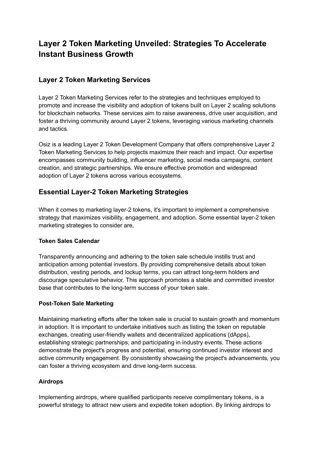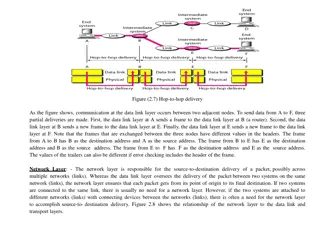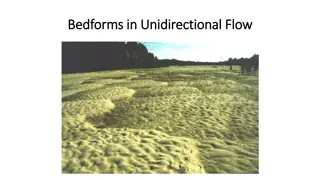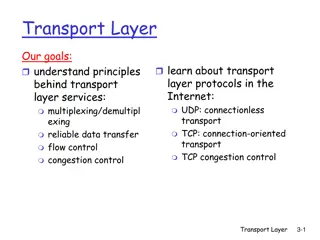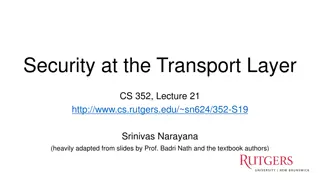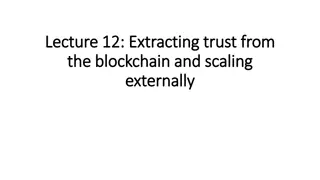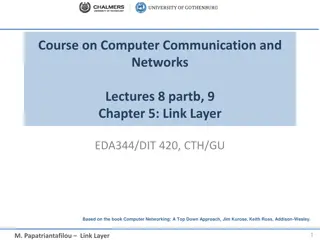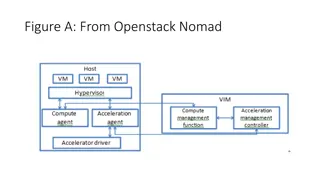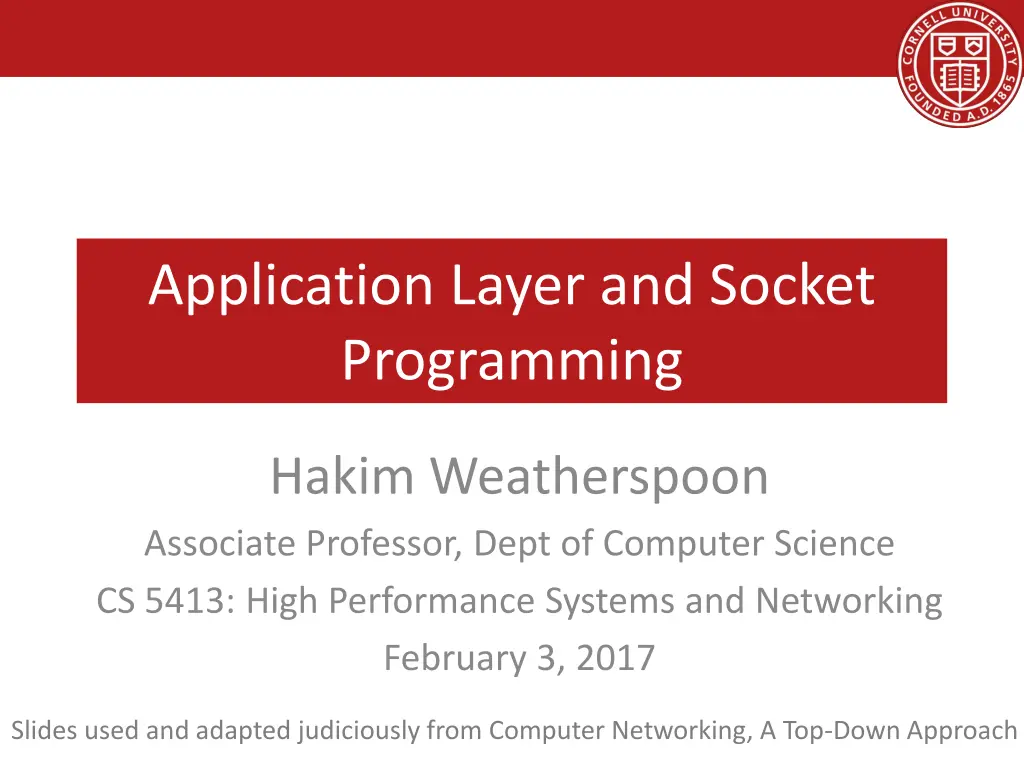
Understanding Network Application Layer Concepts
Delve into the world of network application layer concepts with slides adapted from a top-down approach to computer networking. Explore topics such as socket programming, client-server architecture, and various network applications like email, web, streaming, and more. Discover how to create network applications, optimize system and network performance, and grasp the fundamentals of client-server communication.
Download Presentation

Please find below an Image/Link to download the presentation.
The content on the website is provided AS IS for your information and personal use only. It may not be sold, licensed, or shared on other websites without obtaining consent from the author. If you encounter any issues during the download, it is possible that the publisher has removed the file from their server.
You are allowed to download the files provided on this website for personal or commercial use, subject to the condition that they are used lawfully. All files are the property of their respective owners.
The content on the website is provided AS IS for your information and personal use only. It may not be sold, licensed, or shared on other websites without obtaining consent from the author.
E N D
Presentation Transcript
Application Layer and Socket Programming Hakim Weatherspoon Associate Professor, Dept of Computer Science CS 5413: High Performance Systems and Networking February 3, 2017 Slides used and adapted judiciously from Computer Networking, A Top-Down Approach
Administrivia Project Teams: due by Monday Lab1 due today Next week Lab2 done in class next Friday (Feb 10) HW1: Single threaded TCP proxy handed out next week Done in groups Project Teams due Monday (Feb 6), Project Ideas due following Monday (Feb 13) Review chapter 3 from the book, Transport Layer We will also briefly discuss data center topologies Check website for updated schedule
Big Picture How do we understand and optimize the (datacenter) systems and network at scale? Internet
Goals for Today Application Layer Example network applications conceptual, implementation aspects of network application protocols client-server paradigm transport-layer service models Socket Programming Client-Server Example Backup Slides Web Caching DNS (Domain Name System)
Some network apps e-mail web text messaging remote login P2P file sharing multi-user network games streaming stored video (YouTube, Hulu, Netflix) voice over IP (e.g., Skype) real-time video conferencing social networking search
Creating a network app application transport network data link physical write programs that: run on (different) end systems communicate over network e.g., web server software communicates with browser software no need to write software for network-core devices network-core devices do not run user applications applications on end systems allows for rapid app development, propagation application transport network data link physical application transport network data link physical
Client-Server Architecture server: always-on host permanent IP address data centers for scaling clients: communicate with server may be intermittently connected may have dynamic IP addresses do not communicate directly with each other client/server
Network Applications Communicating Processes clients, servers process: program running within a host within same host, two processes communicate using inter-process communication (defined by OS) processes in different hosts communicate by exchanging messages client process:process that initiates communication server process:process that waits to be contacted aside: applications with P2P architectures have client processes & server processes
Network Applications process sends/receives messages to/from its socket socket analogous to door sending process shoves message out door sending process relies on transport infrastructure on other side of door to deliver message to socket at receiving process application process application process socket controlled by app developer transport transport controlled by OS network network link link Internet physical physical
Network Applications How to identify network applications? identifier includes both IP address and port numbers associated with process on host. example port numbers: HTTP server: 80 mail server: 25 to send HTTP message to www.cs.cornell.edu web server: IP address: 132.236.207.20p port number: 80 to receive messages, process must have identifier host device has unique 32- bit IP address Q: does IP address of host on which process runs suffice for identifying the process? A: no, many processes can be running on same host
Network Applications App-Layer protocols define: types of messages exchanged, e.g., request, response message syntax: what fields in messages & how fields are delineated message semantics meaning of information in fields rules for when and how processes send & respond to messages open protocols: defined in RFCs allows for interoperability e.g., HTTP, SMTP proprietary protocols: e.g., Skype
Communicating Processes Network Applications What transport layer services does an app need? throughput some apps (e.g., multimedia) require minimum amount of throughput to be effective other apps ( elastic apps ) make use of whatever throughput they get data integrity some apps (e.g., file transfer, web transactions) require 100% reliable data transfer other apps (e.g., audio) can tolerate some loss timing some apps (e.g., Internet telephony, interactive games) require low delay to be effective security encryption, data integrity,
Network Applications What transport layer services does an app need? application throughput data loss time sensitive file transfer e-mail Web documents real-time audio/video elastic elastic elastic audio: 5kbps-1Mbps video:10kbps-5Mbps same as above few kbps up elastic no loss no loss no loss loss-tolerant no no no yes, 100 s msec stored audio/video interactive games text messaging loss-tolerant loss-tolerant no loss yes, few secs yes, 100 s msec yes and no
Network Applications Transport Protocol Services TCP service: reliable transport between sending and receiving process flow control: sender won t overwhelm receiver congestion control: throttle sender when network overloaded does not provide: timing, minimum throughput guarantee, security connection-oriented: setup required between client and server processes UDP service: unreliable data transfer between sending and receiving process does not provide: reliability, flow control, congestion control, timing, throughput guarantee, security, or connection setup, Q: why bother? Why is there a UDP?
Network Applications Transport Protocol Services application layer protocol underlying transport protocol application SMTP [RFC 2821] Telnet [RFC 854] HTTP [RFC 2616] FTP [RFC 959] HTTP (e.g., YouTube), RTP [RFC 1889] SIP, RTP, proprietary (e.g., Skype) e-mail TCP TCP TCP TCP TCP or UDP remote terminal access Web file transfer streaming multimedia Internet telephony TCP or UDP
Network Applications: Securing TCP TCP & UDP no encryption cleartext passwds sent into socket traverse Internet in cleartext SSL provides encrypted TCP connection data integrity end-point authentication SSL is at app layer Apps use SSL libraries, which talk to TCP SSL socket API cleartext passwds sent into socket traverse Internet encrypted See Chapter 7
Goals for Today Application Layer Example network applications conceptual, implementation aspects of network application protocols client-server paradigm transport-layer service models Socket Programming Client-Server Example Backup Slides Web Caching DNS (Domain Name System)
Socket Programming goal: learn how to build client/server applications that communicate using sockets socket: door between application process and end-end- transport protocol application process application process socket controlled by app developer transport transport controlled by OS network network link link Internet physical physical
Socket Programming Two socket types for two transport services: UDP: unreliable datagram TCP: reliable, byte stream-oriented Application Example: 1. Client reads a line of characters (data) from its keyboard and sends the data to the server. 2. The server receives the data and converts characters to uppercase. 3. The server sends the modified data to the client. 4. The client receives the modified data and displays the line on its screen. More socket examples at https://docs.python.org/2/library/socket.html
Socket Programming w/ UDP UDP: no connection between client & server no handshaking before sending data sender explicitly attaches IP destination address and port # to each packet rcvr extracts sender IP address and port# from received packet UDP: transmitted data may be lost or received out-of-order Application viewpoint: UDP provides unreliable transfer of groups of bytes ( datagrams ) between client and server
Socket Programming w/ UDP client server (running on serverIP) create socket: clientSocket = socket(AF_INET,SOCK_DGRAM) create socket, port= x: serverSocket = socket(AF_INET,SOCK_DGRAM) Create datagram with server IP and port=x; send datagram via clientSocket read datagram from serverSocket write reply to serverSocket specifying client address, port number read datagram from clientSocket close clientSocket
Socket Programming w/ UDP Python UDPClient include Python s socket library from socket import * serverName = 'localhost' serverPort = 12000 clientSocket = socket(AF_INET, SOCK_DGRAM) create UDP socket for server get user keyboard input message = raw_input('Input lowercase sentence:') Attach server name, port to message; send into socket clientSocket.sendto(message,(serverName, serverPort)) modifiedMessage, serverAddress = clientSocket.recvfrom(2048) print modifiedMessage clientSocket.close() read reply characters from socket into string print out received string and close socket
Socket Programming w/ UDP Python UDPServer from socket import * serverPort = 12000 serverSocket = socket(AF_INET, SOCK_DGRAM) serverSocket.bind(('', serverPort)) print 'The server is ready to receive' while 1: message, clientAddress = serverSocket.recvfrom(2048) modifiedMessage = message.upper() serverSocket.sendto(modifiedMessage, clientAddress) create UDP socket bind socket to local port number 12000 loop forever Read from UDP socket into message, getting client s address (client IP and port) send upper case string back to this client
Socket Programming w/ TCP client must contact server server process must first be running server must have created socket (door) that welcomes client s contact when contacted by client, server TCP creates new socket for server process to communicate with that particular client allows server to talk with multiple clients source port numbers used to distinguish clients (more in Chap 3) client contacts server by: Creating TCP socket, specifying IP address, port number of server process when client creates socket: client TCP establishes connection to server TCP application viewpoint: TCP provides reliable, in-order byte-stream transfer ( pipe ) between client and server
Socket Programming w/ TCP client server (running onhostid) create socket, port=x, for incoming request: serverSocket = socket() wait for incoming connection request connectionSocket = serverSocket.accept() create socket, connect to hostid, port=x clientSocket = socket() TCP connection setup send request using clientSocket read request from connectionSocket write reply to connectionSocket read reply from clientSocket close connectionSocket close clientSocket
Socket Programming w/ TCP Python TCPClient from socket import * serverName = 'localhost' serverPort = 12000 clientSocket = socket(AF_INET, SOCK_STREAM) clientSocket.connect((serverName,serverPort)) sentence = raw_input('Input lowercase sentence:') clientSocket.send(sentence) modifiedSentence = clientSocket.recv(1024) print 'From Server:', modifiedSentence clientSocket.close() create TCP socket for server, remote port 12000 No need to attach server name, port
Socket Programming w/ TCP Python TCPServer from socket import * serverPort = 12000 serverSocket = socket(AF_INET,SOCK_STREAM) serverSocket.bind(('',serverPort)) serverSocket.listen(1) print 'The server is ready to receive' while 1: connectionSocket, addr = serverSocket.accept() sentence = connectionSocket.recv(1024) capitalizedSentence = sentence.upper() connectionSocket.send(capitalizedSentence) connectionSocket.close() create TCP welcoming socket server begins listening for incoming TCP requests loop forever server waits on accept() for incoming requests, new socket created on return read bytes from socket (but not address as in UDP) close connection to this client (but not welcoming socket)
Perspective specific protocols: HTTP FTP SMTP, POP, IMAP DNS P2P: BitTorrent, DHT socket programming: TCP, UDP sockets application architectures client-server P2P application service requirements: reliability, bandwidth, delay Internet transport service model connection-oriented, reliable: TCP unreliable, datagrams: UDP Application Layer is the same in a data center!
Before Next time Project Group: Make sure that you are part of one Finish Lab0 No required reading and review due But, review chapter 3 from the book, Transport Layer We will also briefly discuss Data center TCP (DCTCP), Mohammad Alizadeh, Albert Greenberg, David A. Maltz, Jitendra Padhye, Parveen Patel, Balaji Prabhakar, Sudipta Sengupta, and Murari Sridharan. ACM SIGCOMM Computer Communications Review, Volumne 40, Issue 4 (August 2010), pages 63-74. Check website for updated schedule
Goals for Today Application Layer Example network applications conceptual, implementation aspects of network application protocols client-server paradigm transport-layer service models Socket Programming Client-Server Example Backup Slides Web Caching DNS (Domain Name System)
Web Caches (proxies) goal: satisfy client request without involving origin server user sets browser: Web accesses via cache browser sends all HTTP requests to cache object in cache: cache returns object else cache requests object from origin server, then returns object to client proxy server client origin server client origin server
Web Caches (proxies) cache acts as both client and server server for original requesting client client to origin server typically cache is installed by ISP (university, company, residential ISP) why Web caching? reduce response time for client request reduce traffic on an institution s access link Internet dense with caches: enables poor content providers to effectively deliver content (so too does P2P file sharing)
Web Caching Example assumptions: avg object size: 100K bits avg request rate from browsers to origin servers:15/sec avg data rate to browsers: 1.50 Mbps RTT from institutional router to any origin server: 2 sec access link rate: 1.54 Mbps consequences: LAN utilization: 15% access link utilization = 99% total delay = Internet delay + access delay + LAN delay = 2 sec + minutes + usecs origin servers public Internet 1.54 Mbps access link problem! institutional network 1 Gbps LAN
Web Caching Example: Fatter access Link assumptions: avg object size: 100K bits avg request rate from browsers to origin servers:15/sec avg data rate to browsers: 1.50 Mbps RTT from institutional router to any origin server: 2 sec access link rate: 1.54 Mbps consequences: LAN utilization: 15% access link utilization = 99% total delay = Internet delay + access delay + LAN delay = 2 sec + minutes + usecs origin servers public Internet 154 Mbps 1.54 Mbps access link 154 Mbps 9.9% institutional network 1 Gbps LAN msecs Cost: increased access link speed (not cheap!)
Web Caching Example: Install Local Cache assumptions: avg object size: 100K bits avg request rate from browsers to origin servers:15/sec avg data rate to browsers: 1.50 Mbps RTT from institutional router to any origin server: 2 sec access link rate: 1.54 Mbps consequences: LAN utilization: 15% access link utilization = 100% total delay = Internet delay + access delay + LAN delay = 2 sec + minutes + usecs ? How to compute link utilization, delay? origin servers public Internet 1.54 Mbps access link institutional network ? 1 Gbps LAN local web cache Cost: web cache (cheap!)
Web Caching Example: Install Local Cache Calculating access link utilization, delay with cache: suppose cache hit rate is 0.4 40% requests satisfied at cache, 60% requests satisfied at origin access link utilization: 60% of requests use access link data rate to browsers over access link = 0.6*1.50 Mbps = .9 Mbps utilization = 0.9/1.54 = .58 origin servers public Internet 1.54 Mbps access link institutional network total delay = 0.6 * (delay from origin servers) +0.4 * (delay when satisfied at cache) = 0.6 (2.01) + 0.4 (~msecs) = ~ 1.2 secs less than with 154 Mbps link (and cheaper too!) 1 Gbps LAN local web cache
Web Caching Example: Conditional GET server client Goal: don t send object if cache has up-to-date cached version no object transmission delay lower link utilization cache: specify date of cached copy in HTTP request If-modified-since: <date> server: response contains no object if cached copy is up-to-date: HTTP/1.0 304 Not Modified HTTP request msg If-modified-since: <date> object not modified before <date> HTTP response HTTP/1.0 304 Not Modified HTTP request msg If-modified-since: <date> object modified after <date> HTTP response HTTP/1.0 200 OK <data>
Goals for Today Application Layer Example network applications conceptual, implementation aspects of network application protocols client-server paradigm transport-layer service models Socket Programming Client-Server Example Backup Slides Web Caching DNS (Domain Name System)
DNS (Domain Name System) Domain Name System: distributed database implemented in hierarchy of many name servers application-layer protocol: hosts, name servers communicate to resolve names (address/name translation) note: core Internet function, implemented as application- layer protocol complexity at network s edge people: many identifiers: SSN, name, passport # Internet hosts, routers: IP address (32 bit) - used for addressing datagrams name , e.g., www.yahoo.com - used by humans Q: how to map between IP address and name, and vice versa ?
DNS Structure why not centralize DNS? single point of failure traffic volume distant centralized database maintenance DNS services hostname to IP address translation host aliasing canonical, alias names mail server aliasing load distribution replicated Web servers: many IP addresses correspond to one name A: doesn t scale!
DNS Structure A distributed hierarchical database Root DNS Servers org DNS servers edu DNS servers com DNS servers umass.edu DNS servers cornell.edu DNS servers pbs.org DNS servers yahoo.com DNS servers amazon.com DNS servers client wants IP for www.amazon.com; 1st approx: client queries root server to find com DNS server client queries .com DNS server to get amazon.com DNS server client queries amazon.com DNS server to get IP address for www.amazon.com
DNS Structure Root name servers contacted by local name server that can not resolve name root name server: contacts authoritative name server if name mapping not known gets mapping returns mapping to local name server c. Cogent, Herndon, VA (5 other sites) d. U Maryland College Park, MD h. ARL Aberdeen, MD j. Verisign, Dulles VA (69 other sites ) k. RIPE London (17 other sites) i. Netnod, Stockholm (37 other sites) m. WIDE Tokyo (5 other sites) e. NASA Mt View, CA f. Internet Software C. Palo Alto, CA (and 48 other sites) 13 root name servers worldwide a. Verisign, Los Angeles CA (5 other sites) b. USC-ISI Marina del Rey, CA l. ICANN Los Angeles, CA (41 other sites) g. US DoD Columbus, OH (5 other sites)
DNS Structure Top-Level Domain (TLD) and Authoritative Servers top-level domain (TLD) servers: responsible for com, org, net, edu, aero, jobs, museums, and all top-level country domains, e.g.: uk, fr, ca, jp Network Solutions maintains servers for .com TLD Educause for .edu TLD authoritative DNS servers: organization s own DNS server(s), providing authoritative hostname to IP mappings for organization s named hosts can be maintained by organization or service provider
DNS Structure Local DNS Name Servers does not strictly belong to hierarchy each ISP (residential ISP, company, university) has one also called default name server when host makes DNS query, query is sent to its local DNS server has local cache of recent name-to-address translation pairs (but may be out of date!) acts as proxy, forwards query into hierarchy
DNS Structure: Resolution example root DNS server 2 3 host at cis.poly.edu wants IP address for www.cs.cornell.edu TLD DNS server 4 5 local DNS server dns.poly.edu iterated query: contacted server replies with name of server to contact I don t know this name, but ask this server 6 7 1 8 authoritative DNS server dns.cs.cornell.edu requesting host cis.poly.edu www.cs.cornell.edu
DNS Structure: Resolution example root DNS server 3 2 recursive query: puts burden of name resolution on contacted name server heavy load at upper levels of hierarchy? 7 6 TLD DNS server local DNS server dns.poly.edu 4 5 1 8 authoritative DNS server dns.cs.cornell.edu requesting host cis.poly.edu www.cs.cornell.edu
DNS Structure Caching and Updating Records once (any) name server learns mapping, it caches mapping cache entries timeout (disappear) after some time (TTL) TLD servers typically cached in local name servers thus root name servers not often visited cached entries may be out-of-date (best effort name-to-address translation!) if name host changes IP address, may not be known Internet-wide until all TTLs expire update/notify mechanisms proposed IETF standard RFC 2136
DNS Structure DNS Records DNS: distributed db storing resource records (RR) RR format:(name, value, type, ttl) type=A nameis hostname valueis IP address type=CNAME name is alias name for some canonical (the real) name www.ibm.comis really servereast.backup2.ibm.com valueis canonical name type=NS name is domain (e.g., foo.com) value is hostname of authoritative name server for this domain type=MX valueis name of mailserver associated withname
DNS Structure DNS Protocol and Messages query and reply messages, both with same message format 2 bytes 2 bytes msg header identification: 16 bit # for query, reply to query uses same # flags: query or reply recursion desired recursion available reply is authoritative identification flags # questions # answer RRs # additional RRs # authority RRs questions (variable # of questions) answers (variable # of RRs) authority (variable # of RRs) additional info (variable # of RRs)
DNS Structure DNS Protocol and Messages 2 bytes 2 bytes identification flags # questions # answer RRs # additional RRs # authority RRs name, type fields for a query questions (variable # of questions) RRs in response to query records for authoritative servers answers (variable # of RRs) authority (variable # of RRs) additional helpful info that may be used additional info (variable # of RRs)



